The Two Voice Pro: not just another synth! To be exact, THE hype American mono/duophon analog synth. The reincarnation of the LEGENDARY Two Voice of 1975. And Tom Oberheim’s personal synth favourite. The modern Two Voice: something for PROfessionals.
Whereby PRO pertains to those little and big differences between the 70’s original and the update of today. The SEM modules haven’t really been changed at all (so we’ve still got that wonderful sound), but in the sequencer- and performance-department, the new Two Voice is a (no, it’s two) giant steps.
There’s the excellent velocity / aftertouch sensitive keyboard, the important octave transposition switch, real wheels (pitchbend and mod-wheel), a comprehensive patchbay with CV-ins and -outs, a tricky step-sequencer with lots of memory space, a variety of play modes (unison, alternating, split, …) and MIDI plus some extra CV-outputs on the back. Pure luxury!
The analog synth of your dreams? Not necessarily (surprise, surprise). But one after the other. Let’s start with the …
… concept
Actually, it’s all clear. We already have the legendary (original) SEM-synthesizers. Instruments with the most powerful analog filter of all time (well, maybe)! Around since 1974/75 and experiencing a revival since 2010, the SEM modules are definitely back again. The new SEM with MIDI and the new SEM with CV-panel, both united in the SEM PRO module (MIDI plus CV-panel). Multiply all the technology by two (2 SEMs), add a keyboard and a step-sequencer … and voilà: we have the Two Voice Pro.
The Two Voice Pro features:
- 2x SEM (SEM A/B); 4 VCOs, 2 VCFs, 4 ADS, 2 LFOs in total
- 2x 16 step-sequencer (row A/B)
- 50 memory locations for (polyphonic) sequences
- 9 memory locations for songs
- 2x sample/hold
- 2x portamento
- 2x volume and pan
- Various keyboard / SEM control modes
- 3-octave keyboard with velocity and aftertouch
- Vel/AT to VCF and/or VCA
- Pitch wheel (programmable: 1 – 12 semi-tones)
- Modulation wheel (freely routable via CV output)
- TUNE knob
- VCO2 detune knob (for both SEMs!)
- Additional (global) vibrato-LFO (mod-wheel or AT control)
- Transpose function (-2/-1/0/+1/+2 octaves), adjustable for each SEM
- CV-panel (for mod-wheel, Vel, AFT, vibrato-LFO, S/H, sequencer, SEM A, SEM B)
- MIDI (In/Out/Thru), Audio-In (2x), CV/Gate Out (SEM A and SEM B, MIDI-to-CV!)
- Audio-Out R/L, Headphones Out
3 things to convince you …
Flexibility. The first magic word. Dynamic control of the SEM modules (via MIDI and/or keyboard). Lots of patch points for internal / external modulation routings. Rapid changes in sound via the (routable) modulation wheel. Independent velocity control on each SEM. Individual SEM control: keyboard, S/H, sequencer … and any combination of these. All those possible choices are what make the difference.
Noble sound. The second magic word. 4 VCOs, 2 MultiMode VCFs, true stereo! The sound is overpowering. It was the reason for Oberheim’s instant success in the 70s. And it remains one of the nicest analog synth sounds ever. Most characteristic part of the SEM is the MultiMode VCF. Simply beautiful!
“Each SEM is a true analog synthesizer, very much like the original Minimoog, ARP 2600, and the Oberheim Four Voice and Eight Voice polyphonic synths. What we mean by this is that the SEM is 100% analog! (Not just its “signal path”).”
— TVS Pro Quickstart Manual, page 4 —
Well-crafted. The third magic word. Despite its surprising lightness, it’s all there. Exceptional quality, with one exception. In fact, one very positive surprise is the internal PSU, which ranges from 100V to 240V. No switching back and forth, no risk of overvoltage. What a luxury! The SEMs feature a high level of workmanship. The keyboard is a pleasure to play.
One detrimental aspect is the small, wobbly knobs on the left side of the instrument (sequencer / keyboard-MIDI-module / performance-department). Not state of the art, really!
These are the absolute strengths of the Two Voice Pro. So why are there any doubts that this instrument is the synth of your dreams? Well …
… but that’s not all
Even if the Two Voice Pro has been long-awaited, it is actually not the epitome of synth development. It sounds great, of course. It’s easy to use. It’s very compact and extremely flexible … BUT … just the same … it doesn’t quite meet up …
One aspect is the onboard sequencer. One thing, to be honest, you could do without! I hear those protests coming … but I stick to my opinion. The sequencer could be the instrument’s highlight, but … it’s not. There are several reasons for this.
On the one hand, it’s a tiny bit complicated to use. On the other hand, it is not very flexible. You HAVE to select SEQ mode for both SEMs in order to get any sequencer cv-signal from the patch panel. (What about playing the Two Voice live, while controlling both SEM’s VCFs via the sequencer, e.g.? Well … that’s not possible.)
Another aspect is hardware. The knobs in the instrument’s left area are wobbly and of mediocre quality and they are too small! SEM A and SEM B VOLUME should be the biggest knobs of the Two Voice Pro, but in fact they are the tiniest! This is a 4000 Euros instrument (well, in Europe) … so one should expect the highest possible quality. [Price in the US is lower, we have to admit: 3495 USD, which is a more attractive offer.]
Which brings us to the question of whether …
… there aren’t any alternatives to the Two Voice Pro. To be definite: yes! And it even comes from Oberheim itself. In my humble opinion, of course …
Let’s backtrack a little. What exactly is the focus of the Two Voice Pro? It seems to me it’s its sound and its flexibility in terms of interfacing. And both of these are – now we’re getting to the point – can be found in the SEM PRO module.
Our suggestion: take two SEM PROs, place them side by side and – Bingo! – you’ve got an Oberheim Two Voice at two third of the price. (Ok, ok … it’s not half the price, as originally claimed.) Which is to say, you can do without the step sequencer (and without S/H), since it is limited in terms of routing flexibility.
Hook up two SEM PROs with a nice 5-octave masterkeyboard, and you’ve got the same MIDI-control as with the Two Voice Pro along with a larger keyboard (61 keys). What more could you want? Is S/H irreplacable? No – you can get that externally. Can you play two SEM PRO unison? Yes? Alternating? Yes … Everything is possible.
… and of how the Two Voice Pro performs as it does
It’s quite easy. If you’re looking for an all-in-one solution (two SEMs, keyboard, sequencer), then there is no alternative to the Two Voice Pro. A fantastic sounding instrument both in studio and on stage. A pricy instrument, too … but well, if you can afford it – take it!
If it’s the SEM sound you’re heading for, then go for a pair of SEM PRO modules. No sequencer, but the same classy sound for much less money.
In a nutshell …
The Two Voice Pro: flexible, noble sound, well-crafted (hmmmmm … most of it!). Those of you willed (and able) to make the big investment, will get a partner for life for your money. A partner which might turn out to be a control centre for a modular/MIDI setup. A partner on the stage (small sized, low weight and flexible sound architecture). In the end a partner with a fantastic sound. Summa summarum, Tom Oberheim’s own favourite analog synth!
Again: if the Two Voice Pro is too expensive for you, two SEM PRO modules placed side by side are definitely (and acoustically) an alternative.
Look, this is all about sound. About the sound of two SEMs, which is not just beautiful, but gorgeous! A sound in a class of its own.
We have attached 40 minutes of audio material. Enjoy the sound of the Two Voice Pro! Just in case you wonder what the JH-3200 is … it’s the Korg PS-3100/3200 clone, a one-off made by Juergen Haible in 2001/2002. “Flanger” soundfile: Roland SBF-325!
Have a hear in the soundfiles …
PS: There’s some discussion (see below) about whether the new SEM sounds identical to the old. I think the question should be: “Does the new SEM sound good?” … answer: “Yes, it sounds excellent!” Tom Oberheim has done his best to make a new Two Voice Synthesizer that comes extremely close to the original. And then there are the bonuses: vast CV-panel, MIDI, wheels, etc. All those performance possibilities combined with two well-made (and powerful) SEMs – what else could you want?
Tom Oberheim (Marion Systems)
Two Voice Pro
Duophonic Analog Synthesizer
(2 SEM Modules + Sequencer + Keyboard)
Price: 3,495 USD / approx. 4,000 Euros
SEM PRO
Monophonic Analog Synthesizer
Desktop Format
Price: 1,199 USD, approx. 1,400 Euros
Website Manufacturer:
www.tomoberheim.com



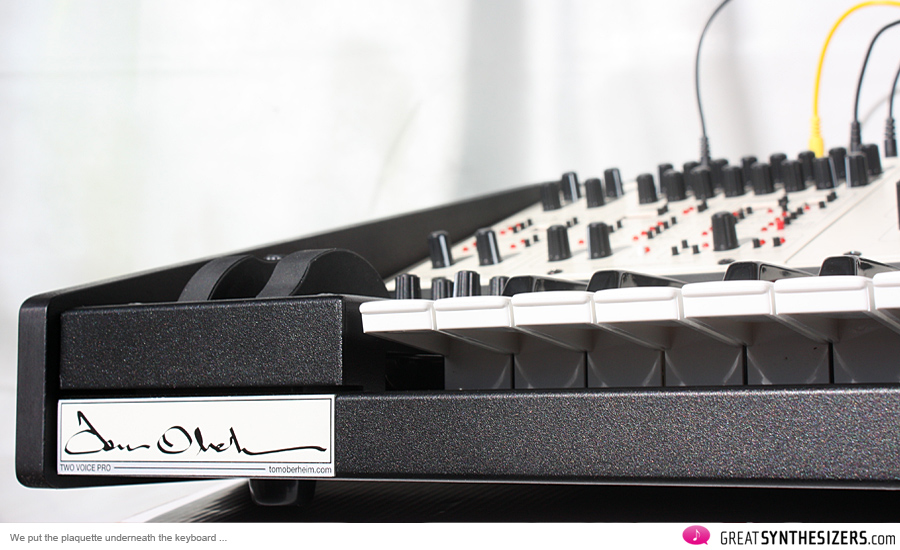


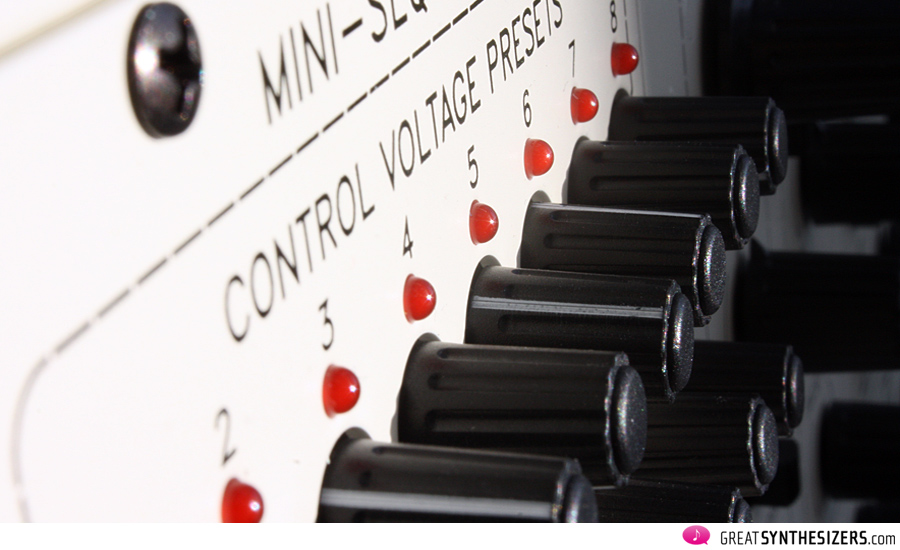
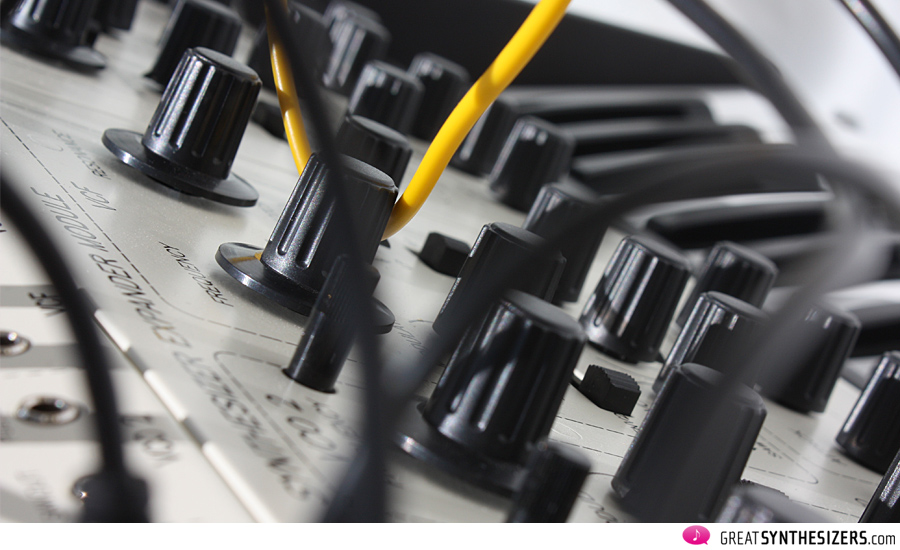
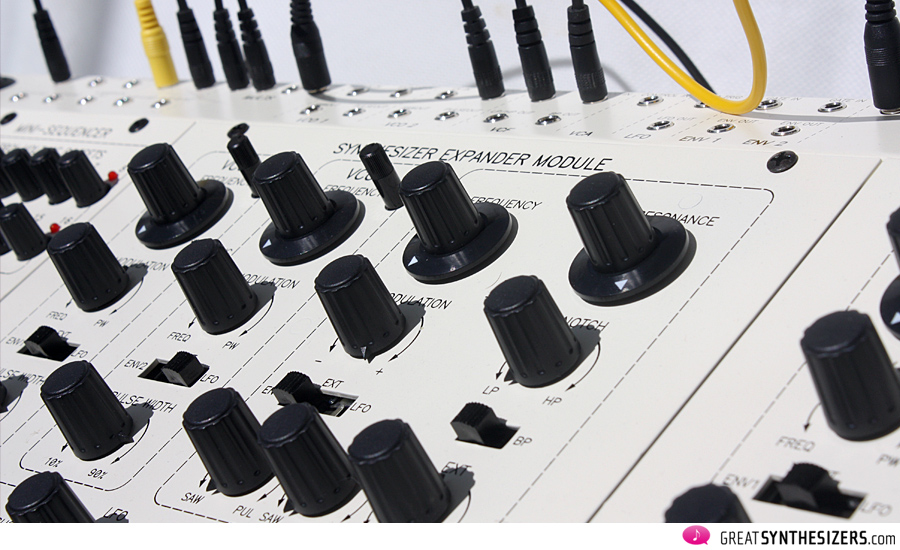

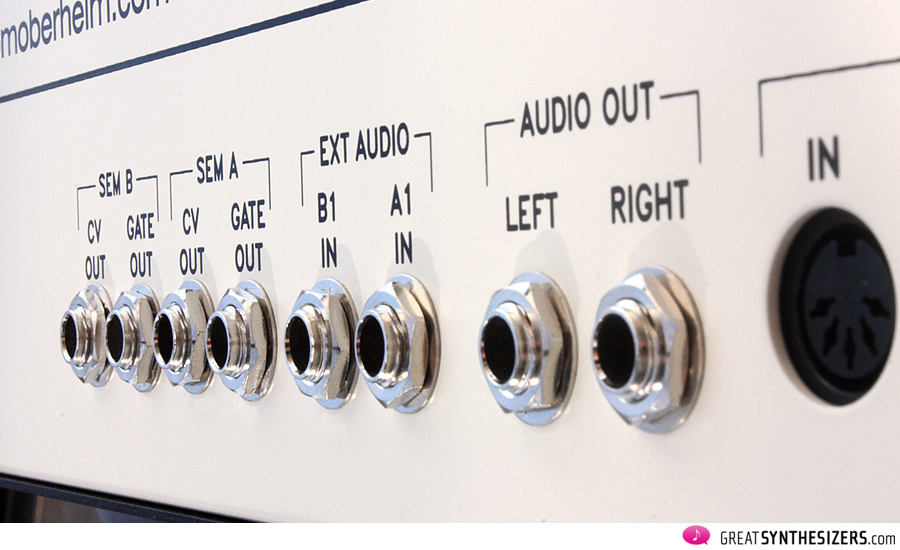

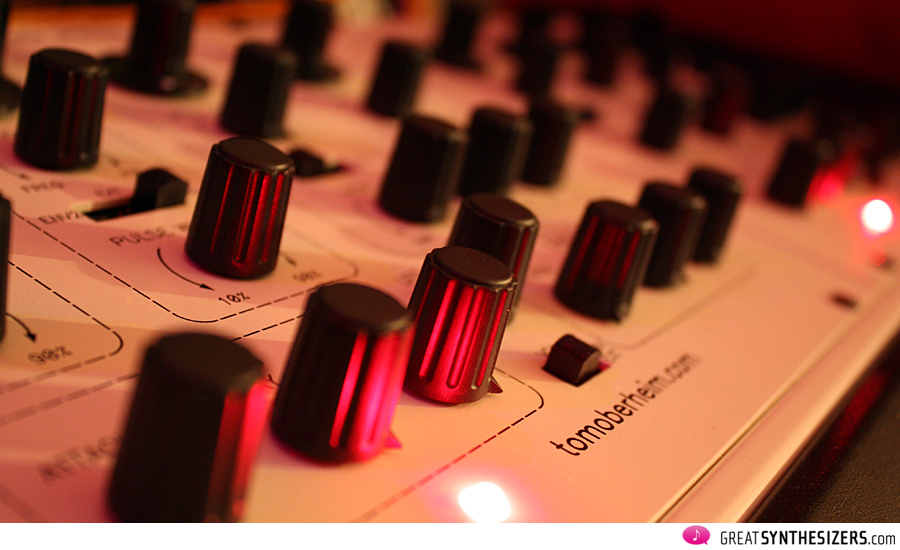

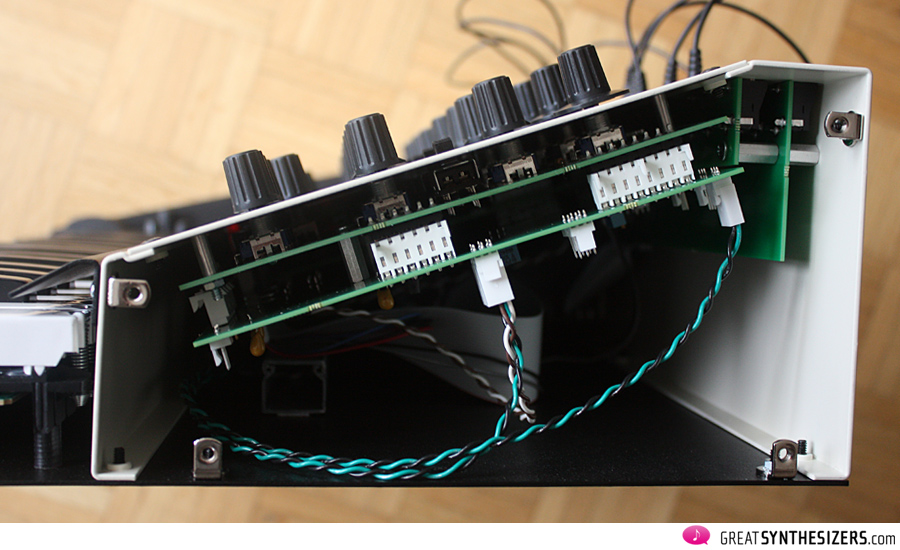
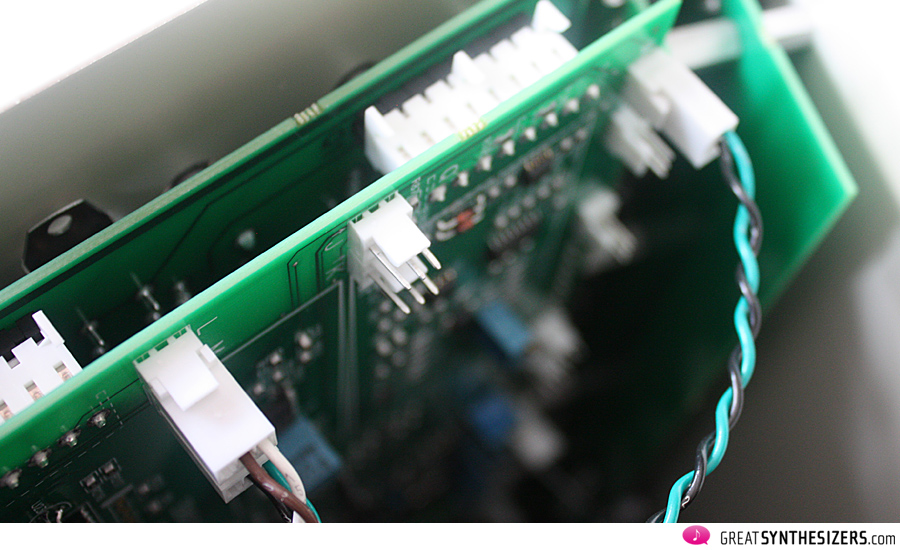
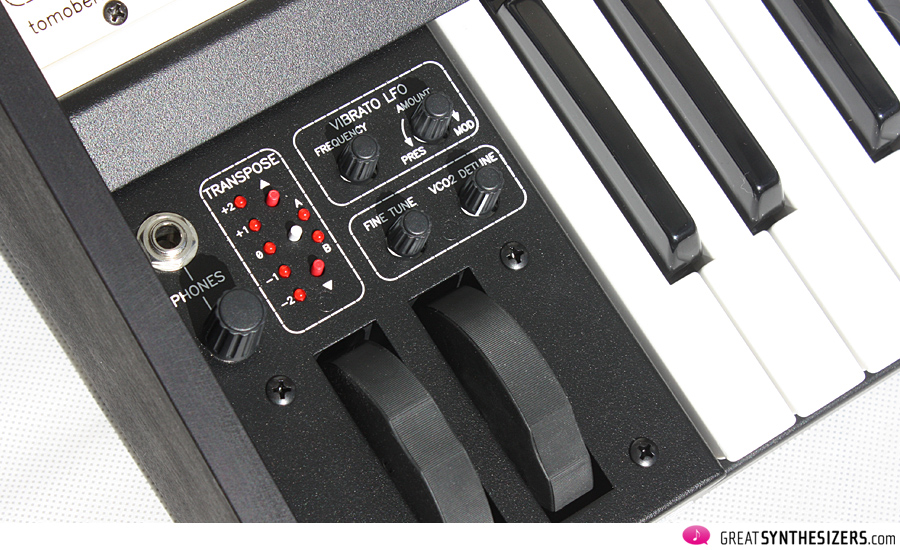
Great review and sounds too. Is the new SEM and exact clone of an old SEM? Ben
… differences in hardware (other components in 2010 than in 1975), but no difference in sound. I’d say yes, it’s an exact clone …
Cheers …
Nice demos as allways!
But, to answer to Ben: although new SEM is really juicy and nice sounding and I love it, it has nothing to do with old one soundwise. It simply sunds much more clear and rounded. I would say it is due to a new components.
Used to own a real SEM and an original 4-voice, and currently own an original 2-voice and real SEM. Bought a new SEM Pro a couple years ago. Played the new SEM side by side with the old. No comparison. The new is not a clone of the old. Sounds nothing like the old. A quick Google or Gearslutz search will give you this information from those who have actually played and compared the two.
… hmmmm, I agree. You and Rod, you’re right. At least the new SEM oscillators sound more clear (more precise?). I have the original Four Voice here, too … but, to be honest, I’m “not” sure if the fatness and out-of-tune character of the original SEMs isn’t due to the instrument’s age. Both my Sequential Prophet-5 and Oberheim OB-8 are (more or less) permanently out of tune – I think they sound great – and it gets worse (more beautiful?) over the years. Who knows what the original SEM sounded like in 1975? I don’t …
I really like the comprehensive patch points which allow a flexible and powerful combination with an external euro rack synth. In fact with an A100 system from Doepfer it opens a wide sound cosmos and it’s great fun to exercise insomnia effects due to constant sound research activities.
Really great review , I think it’s the 1st one of the new tvs pro , trust me I’ve been looking . Thanks
Quick question on some confusion I’m having .
Are the demo sounds all coming from the two voice pro , if so , why are there other synth names next to some of the demo sounds ?
Quote
“… concept
Actually, it’s all clear. We already have the legendary (original) SEM-synthesizers. Instruments with the most powerful analog filter of all time (well, maybe) ”
What do you mean by this , what makes this filter better than a Arp 2600 or Moog filter , please explain very interesting ?
The demo’s are very impressive and powerful but I wonder can this synth sound warm and pretty like a Arp 2600 ?
Can it make warm brass sounds like a Stevie Wonder Arp 2600 sound .
Can the clock and sequencer be controlled by external midi or cv ?
I notice many of the demo sounds have this awesome rumbling buzz bite , is that a proud trademark of the two voice ?
And is that the sound of the filter giving that rumbling vibration bite or is it mostly from programming .
How would you compare the tvs pro sound to Studio Electronics Boomstar 4075 with the Arp filter ?
I am still learning about all of these great analog synts from the past and present and this one of the best sites for learning so thank you !
Thanks I am very intrigued by the two voice pro .
Hello Roc …
Synth names: the specific soundfile was made with the TVPro “and” the synth in name …
The SEM VCF is among the “Top 3” analog filters in history: MOOG 24dB, ARP VCF (although there are many different versions) and the Oberheim SEM MultiMode VCF. It’s a question of personal taste of course, but considering flexibility, the SEM filter is the best. Sweeping from LowPass to Notch to HighPass (and back again) is unique!
Comparison to the ARP2600: Yes, it sounds as warm (even warmer, in my opinion), but not nearwhere as razor-sharp as the ARP. So, for percussion-sounds and funky, sequenced fx-sounds, the ARP is unbeatable. It has a lot more modulation stuff, and a completely different concept, so: only a 2600 is a 2600! TVPro: Warm brass sounds are possible, though … VCO calibration is very exact (as with the 2600), and the SEM filter is huuuuge …
TVPro – external MIDI clock to sequencer: YES !!!
Correct, that rumbling buzz bite is the massive (legendary) Oberheim oscillator sound. By the way, that VCO2 detune knob is one of the best Two Voice Pro featurs … it detunes the 2nd VCO of each SEM. Further, PAN adjustment is very important … set SEM A to the LEFT, SEM B to the RIGHT … then you got it, the “huge” (stereo) sound!
Comparisons are difficult (and sometimes impossible), so … the Studio Electronics Boomstar is great, but not nearwhere as warm as the SEM module … (in my opinion) …
Cheers,
Theo
Actually, as someone who owns two original SEMs and one new one, the new one is about as different as the two original SEMs are from each other. In other words, it’s pretty much indistinguishable. Don’t worry Rod, your investment will hold…you’re not in danger of losing money. But don’t spread misinformation and untruths out of fear. The new SEM sounds just like the old.
Although if you take opinions from Gearslutz as a sign of veracity, then your ability and ears come into question. You can’t be all that advanced if you listen to the posters on Gearslutz. I’m sure you think Wikipedia is a credible source, as well.
Applause !
Thank You so much for your response !
This site is also a educational tool for musicians learning like me .
I appreciate your passion for all of these synths .
I am attracted to the TVS pro and am considering it but I’m also into funky , soulful , warm sounds and groove for techno and soulful house stuff and experimental grooves and so on .
I know you said the Arp is good for funky sounds but
can the TVS Pro also be funky ?
I’m thinking it would be nice to use with my Voyager XL .
Oh , can the VCOs on the TVS Pro be detuned to make chords , it’s a little confusing because there are no numbers on the frequency knobs to tell you we’re you are on the frequency like Moogs do ?
Thanks Agin !
… ARP-2600 and Two Voice Pro are so different … but speaking of a “funky” sound, I’d go immediately for the ARP (snappier envelopes and straight filtersound).
The SEM VCOs have completely variable tuning in any way. No octave switches as with Moog synthesizers. (But there are the octave transpose knobs to the left of the TVPro keyboard, which is fine.) So, yes, you can – well, you have to – set the VCO ranges by yourself (intervalls) … completely variable tuning (as with the ARP-2600) …
Cheers …
Adding 2 SEM modules is it possible to transform the TWO Voice in a four voice?
Thanks – Gabriel
… sorry, no. What you can do: Buy 4x SEM patchpanel modules + a Vermona polyphonic MIDI Module – that’s a real Oberheim 4-Voice (and just a little more expensive than the Two Voice Pro) …
What did you use to sequence the TVS Pro in your demos?
… it’s the internal Two Voice Pro sequencer …
(PS: it’s “not” possible to add 2 SEMs to make this instrument a 4 Voice) … sorry!
“Our suggestion: take two SEM PROs, place them side by side and – Bingo! – you’ve got an Oberheim Two Voice at (nearly) half the price!”
The math is a bit of a stretch…2 SEM PROs will cost you 69% of what one Two Voice Pro costs. I would not characterize that as “nearly half the price.”
That being said, some useful insights and very nice audio samples.
Are you using any fxs or signal processing in the demos ?
Can you share your recording chain (converters sound excellent ! )
Thanks
… you’re right! That math is a little too optimistic – it will be fixed.
… very simple, actually. Synth > Alesis Mixer and Lexicon MPX100 effects > old MacBook (Audacity, realtime recording). In the GRP A8 soundfile, there’s also a Quantec Room Simulator in use (producing that endless, warm reverb) …
And the brass lead in GRP A8 is very reminiscent of one of the Blade Runner pad sounds, beautiful !
Why can’t you add 2 Sem to a two voice pro for a 4voice ?
Why can you add multiple Sem together ?
Can you connect 2 two voice pros together for a 4voice ?
… you can add as many SEMs as you want, but it won’t increase polyphony. You’ll just have a very FAT monophonic (or duophonic) sound. Problem is the keyboard logic. Playing 4 keys, each key should be addressed to a different SEM. The Vermona (polyphonic) MIDI interface can do this (and some other tricks). This is why 4 SEMs and the Vermona interface would make a “real” Four-Voice. The Two Voice always remains a two voice polyphonic synth, no matter how many additional SEMs you hook up. Even 2 Two Voice Pro don’t make a Four-Voice …
Ordered !
Thanks for all your help !
This is my 1st synth without patch memory and I’m sure it will be a challenge for me hopefully in a good way to come up with nice sounding patches and sequences like you did in the demo’s .
Is there any way or possible for you to share Synth and sequencing Patch Sheets , just for learning of course ?
Thanks
Hello Roc … sorry – there’s no documentantion of any of my recordings (besides the audio) … I always record “on the fly” (which is the quickest). Nevertheless, I hope you enjoy the Two Voice Pro! Cheers, Theo
Ok , I’m really loving the TVS Pro .Thank You
Can you tell me how to use ENV 2 (3 knobs ) on the TVS Pro , I can’t seem to get them to do anything on either module ?
And what are the skinny long black sticks coming up out of the VCO section , what are they for ?
One thing is that The TVS Pro comes with a very very basic quick start guide that don’t go over all it’s functions , a little disappointed with that , is there any where I can get more info on what everything does plus tip and tricks ?
Thanks for all your help
Yes, the quick start guide is a slim and very basic user manual. I’ll send you an email regarding your other questions … cheers …
So… would it be possible to use a Two Voice Pro and two single SEMs with the Vermona interface to create a Four Voice? I know the best solution with the Vermona would be 4 of the new SEMs, but I already own the new Two Voice, so wondering if two additional SEMs would give me this. I guess the trick is if the Two Voice it could respond to midi by having the Vermona send notes to the two inbuilt SEMs separately and independently (and the other two notes to the stand-alone SEMs). I’m trying to remember if the two Two Voice SEMs can respond on different midi channels. Not sure if I even know that. Complicated I guess. You would need a four channel mixer as well, if you wanted a stereo output.
… hello Bob!
Ah, the Vermona interface works the other way round (but it “will” work as you hoped). The interface has a MIDI IN port and 4x cv/gate out (not MIDI OUT!). You can attach the cv/gates directly to your Two Voice Pro (cv/gate 1 and 2) and to the additional external SEMs (cv/gate 3 and 4). That works … and that’s how you get a 4-Voice!
So, besides the Two Voice Pro, you need the Vermona interface and 2 SEM Patchpanel or 2 SEM Pro (not the SEM MIDI!).
Info Vermona interface: http://www.vermona.com/en/products/modules/product/qmi-2/
Cheers, Theo
Thanks Theo – you have enlightened me! I’m thinking seriously about doing this… but of course, the expense!
Any statement that the new SEM “sounds nothing like the old” simply doesn’t hold true.
Whoever claims the above either doesn’t understand or take under account the normal wear of the analog circuits after 40 years of use (and abuse) and the small instabilities introduced thus in the system – that were never meant to be there by the original designer – or he is very anxious to keep the selling price of old synths very high.
Of course for some collectors only vintage equipment is valuable.
But musical instruments are better being used by musicians than amassed by collectors.
So, strictly musically speaking…
The voice architecture, signal path & CV implementation is “as identical as it gets” – given that some (very few actually) components are now obsolete.
The only perceivable difference lies a) in the slowest attack & decay times of the “vintage version” envelopes & b) in the fastest speed & greater modulation depth of the “current version” LFO.
The sound is 99,9% identical, as i had the pleasure to find out in direct comparison between a 1975 vintage SEM & the current reincarnation. And that’s all that counts for me.
…. “musical instruments are better being used by musicians than amassed by collectors.”
You’re so right!
Between this and the analogue solutions Polymath – what would you choose and why? I mean they both are the same price, both with 4 vco’s, SEM or SEM clone filter, modular patching.
Hello Bob!
I actually did it with a Yarns interface from Eurorack Mutable Instruments and it works very well. I have the TVS PRO and 2 SEM with CV. It’s cool but a bit difficult to play it live because of all those knobs to control. At the end, as I find myself everyday in studio, I prefer to stack tracks in Unison mode in Protools for production. It gives me an outstanding fat sound. I always use the 4 SEMS together. A lot of programmation and preparation, but the result is always rewarding. Cheers! Sam
… (as said in the PolyMath comments) – I’d take the TwoVoice Pro. It has all the internal wiring – and an attached keyboard … instant playing! It’s just more fun … (and still has tons of possibilities).
PS: To be honest, the Polymath sequencer is better than the one of the TwoVoice Pro, but well … having both CV/Gate and MIDI, you’re not stuck to the Oberheim sequencer in any way …
The latest firmware allows sequences to be programmed by the keyboard! This makes all the difference in the world!
That’s good news !!!
I’m really trying to decide between this or getting two ARP Odyssey modules and use an external sequencer (Either the Engine sequencer, Carbon sequencer or even the R24 sequencer) Trying to get that Carpenter/Tangerine Dream style sequencing. What I love is the sequencer can pretty much meet all my requirements.
-Transpose sequences on the fly
-Ratchet steps
-Chain sequences into songs.
and to top it off you can have two sequences running at the same time with different patches.
That being said the sequencer does seem a bit convoluted that you have to add rests/ties after the notes are programmed but even so…the fact it’s an all in one unit is pretty astounding.
I’ve been needing some solid SEM sound in my studio for a while and I feel like this just compliments my eurorack stuff so well. Never had an OG sem but I love the way this thing sounds and plays. Very unique synthesizer, not sure there’s anything like it really…
Really glad I held out on buying ob6 for this, I have a p6 already and feel that they are a bit too similar.
… I’d recommend a Tom Oberheim SEM Pro … (or two of them) …
So do I. The OB-6 is great, but IMHO doesn’t hold a candle to the TVP. Think about it. The TVP is not only more expensive, it also puts ALL the money into a pure analog two voice architecture, while the OB-6 must cover not only a more complex 6 voice architecture, but also digital effects, patch memory (not the memory itself, but the software, the buttons, the design, the testing etc.) and such, and for a much lower price.
Hi Theo, Could you provide the dimensions of the instrument in cm? thanks
… Two Voice Pro: 65,5 x 40,5 x 14 cm (width / depth / height) … cheers
Hi theo
Its possible to use the seq alone with an external synth or it can only be used with the 2 voice sems?
Thank you in advance
I have one of these and I absolutely agree with the review. The left side of the instrument should be better for the price. But it’s the right side that counts! Great sound, simple to use, beautiful to behold (including the left side). The suggested alternative (two SEMs and a master keyboard) may be a cheaper (but messy) alternative, but it will never out-class the full package.
Hi Theo bloderer! Questions….? I have 1 SEM pro, plus one SEM patch panel. If I want to make a 4 voices(with the vermona interface) should I by 2 other SEM pro, or patch panel? Actually know a guy who selling 2 SEM pro. If I take them, I will have 3 SEM pro + a patch panels…. It will work? 4 voices? Please help. I just bought the OBX-8. Thinking o out making a trade for 2 SEM pro what do you think?! Am I crazy?? Huge Prince fan for 36 years…. My dream synthesizer is an FVS-1!!!! Missed one lately for 8000 euros!??? ok stop talking. Please need your advices. ?????????